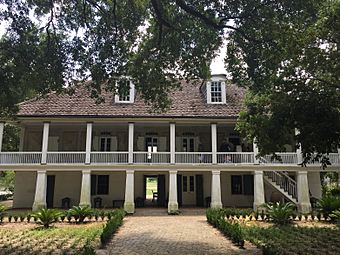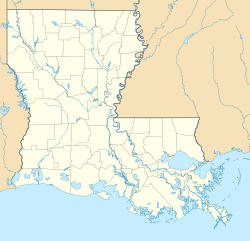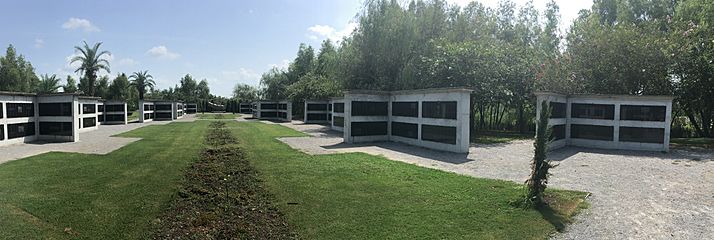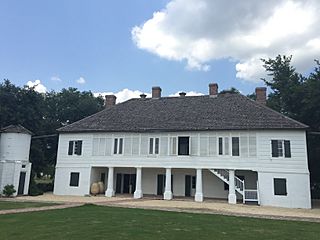Whitney Plantation Historic District facts for kids
Quick facts for kids |
|
|
Whitney Plantation Historic District
|
|

Front of the Big House
|
|
| Nearest city | Wallace, Louisiana |
|---|---|
| Area | 40 acres (16 ha) |
| Built | 1790 |
| Architectural style | Federal, French Creole |
| MPS | Louisiana's French Creole Architecture MPS |
| NRHP reference No. | 92001566 |
| Added to NRHP | November 24, 1992 |
The Whitney Plantation Historic District is a special place in Louisiana. It is a museum that teaches people about the history of slavery in the Southern United States. The museum is located near Wallace, right by the Mississippi River.
This place was first started in 1752 by Ambroise Heidal. He was one of many German immigrants who settled along the river in the 1700s. His family owned the land until 1860. After the American Civil War ended in 1866, a businessman named Bradish Johnson bought the plantation. He renamed it Whitney Plantation to honor his daughter.
Contents
About the Whitney Plantation Museum
The Whitney Plantation was once a very large property, about 1,500 acres. Today, about 200 acres are part of the museum and historic area. The museum first opened to the public in December 2014.
A man named John Cummings, a lawyer from New Orleans, started the museum. He spent over $10 million of his own money on this important project. He worked on it for 20 years! The person in charge of research at the museum is Dr. Ibrahima Seck. He is a scholar from Senegal who studies the history of slavery.
Remembering Enslaved People
The museum has several special places to remember the more than 100,000 men, women, and children who were enslaved in Louisiana. Mr. Cummings also asked artists to create original art for the museum. This includes life-size sculptures of children. These sculptures help tell the stories of people who were born into slavery before the Civil War.
Many people who survived slavery were interviewed when they were adults. This happened during the Great Depression in the 1930s. These interviews, called oral histories, collected the stories of hundreds of the last survivors of slavery in the United States. The government published these stories to make sure they were not forgotten. You can find the written stories and some audio recordings at the Library of Congress.
In 2019, Mr. Cummings gave the entire museum and land to a non-profit group called the Whitney Plantation Museum. This group now owns and runs the site. In February 2025, the United States National Park Service decided not to make the plantation a National Historic Landmark. This happened after the Louisiana Department of Environmental Quality asked them to deny the application.
Historic Buildings and Sites
The main house at Whitney Plantation was built around 1790. It is a great example of French Creole raised-style architecture. The plantation also has many other old buildings. These include a pigeonnier (a dovecote for pigeons), a plantation store, and the only French Creole barn still standing in North America. There is also a separate kitchen, a house for the overseer, a mule barn, and two slave cabins. Other original buildings include a shrimp trap shed, a tractor shed, a manager's house, and a shopkeeper's house.
Archaeological Discoveries
The museum complex also includes three archaeological sites. These are places where experts have dug up and studied old objects. These objects help us learn more about the past.
In 1920, the 1884 Mialaret House and its buildings were added to the plantation. These additions show that the plantation was used for farming well into the 1900s. It stopped being a working plantation in 1975. Some of the land is still used to grow sugarcane today.
The Whitney Plantation historic district was added to the U.S. National Register of Historic Places in 1992. It is also one of 26 important places on the Louisiana African American Heritage Trail.
Who Owned the Whitney Plantation?
The land for the Whitney Plantation was first bought in 1752 by Ambroise Heidel. He was an immigrant from Germany. Over time, his family changed their last name to Haydel. When Ambroise died, his youngest son, Jean Jacques Haydel, took over the land.
In 1820, Jean Jacques Haydel gave the property to his own sons, Jean Jacques Jr. and Marcellin. These brothers later bought another plantation next to the one they already had. After Marcellin died in 1839, his wife, Marie Azélie Haydel, managed the plantation. This was when the plantation made the most money. It became one of Louisiana's most successful sugarcane businesses. By the time Marie Haydel died in 1860, she was one of the largest slaveholders in Louisiana.
After the American Civil War ended, Bradish Johnson bought the plantation in 1866. He renamed it Whitney, after his daughter.
John Cummings bought the Whitney complex in 1999. He spent more than 15 years restoring it before it opened to the public in 2014. He donated the Whitney in 2019. Now, it is a 501(c)(3) organization, which means it is a non-profit group run by a board of directors.
See also
- Evergreen Plantation, another plantation near Wallace
- History of slavery in Louisiana
- Louisiana African American Heritage Trail
- List of plantations in Louisiana
- National Register of Historic Places listings in St. John the Baptist Parish, Louisiana
- Plantation complexes in the Southern United States
- Rural African American Museum, Opelousas





